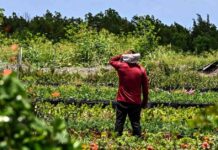A rare parasitic infection known as raccoon roundworm has been confirmed in Los Angeles County, according to the Los Angeles County Department of Public Health. Two individuals in the South Bay area have been diagnosed with Baylisascaris procyonis, a parasitic worm originating from raccoons’ intestines. When this infection occurs in humans, it has the potential to impact the brain, spinal cord, and eyes, leading to conditions such as brain swelling and eye disease, as warned by the health department.
The Centers for Disease Control and Prevention (CDC) explains that after maturing in a raccoon’s intestines, the worms produce eggs that are then excreted through the animal’s feces. These eggs can become infectious within two to four weeks and have the ability to survive for extended periods under suitable conditions. Erica Susky, a certified infection control practitioner in Canada, emphasizes that besides raccoons, other unintentionally infected species may include domestic dogs and humans.
Ingestion of the infective larval stage of the roundworm, either through consuming the infected host or contaminated feces in the environment, leads to the infection of new hosts. While rare, the infection can occur when individuals accidentally ingest the roundworm’s eggs present in raccoon feces found in soil, water, or on tainted objects. Vulnerable groups such as young children and individuals with developmental disabilities are at a higher risk due to their likelihood of inadvertently putting contaminated fingers, soil, or objects into their mouths, as highlighted by the CDC.
Although the infection is not transmissible among people, it remains a concern as a significant number of raccoons coexist near human habitats, potentially indicating a high infection rate within raccoons. Susky notes that the parasite is prevalent in the United States and Canada, with a more common occurrence in Southern latitudes, the Northeast, the Midwest, and the West Coast. Despite fewer than 25 reported cases of raccoon roundworm in the U.S., the actual number could be higher due to misdiagnosis or lack of diagnosis. As of 2018, there had been 23 confirmed cases and six deaths in the country.
Symptoms of raccoon roundworm infection vary based on the quantity of eggs consumed and their path within the body. While some infected individuals may exhibit no symptoms, others may experience nausea, fatigue, enlarged liver, loss of muscle control, coordination difficulties, blindness, coma, and lack of attentiveness towards people and surroundings, as outlined by the CDC. Particularly vulnerable groups at risk of severe disease manifestations include children, seniors aged 65 and above, pregnant women, and individuals with compromised immune systems.
Preventive measures play a crucial role in reducing the risk of raccoon roundworm infections. Dr. Muntu Davis, a health officer with Los Angeles County, emphasizes the interconnectedness between human and animal health, stressing the importance of simple precautions such as regular handwashing, avoiding direct contact with wildlife and their waste, maintaining pet health, and preventing wildlife from residing near homes. Avoiding contact with wild animals or birds, including deceased specimens, is a key preventive measure, according to Susky.
To mitigate the risk of infection, individuals are advised to keep pets indoors whenever feasible and on leashes when outdoors. Regular veterinary check-ups for outdoor pets, including deworming as recommended, are essential. Hand hygiene is particularly crucial to prevent accidental ingestion of eggs present in soil and water. Adults should remind children to wash their hands after outdoor activities to reduce the risk of inadvertently ingesting soil and water containing infectious agents.
In conclusion, awareness and adherence to preventive guidelines are essential in safeguarding against raccoon roundworm infections. By implementing simple yet effective measures, individuals can minimize the risk of exposure to this parasitic infection, ensuring the health and safety of both humans and animals in shared environments.

















